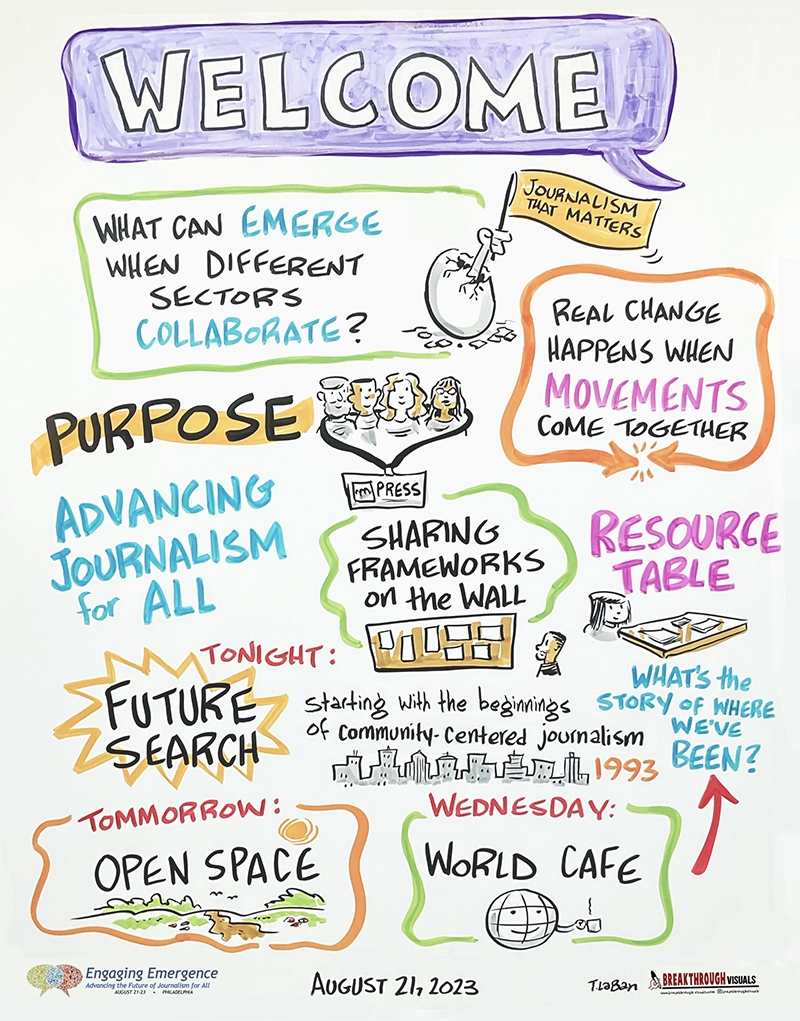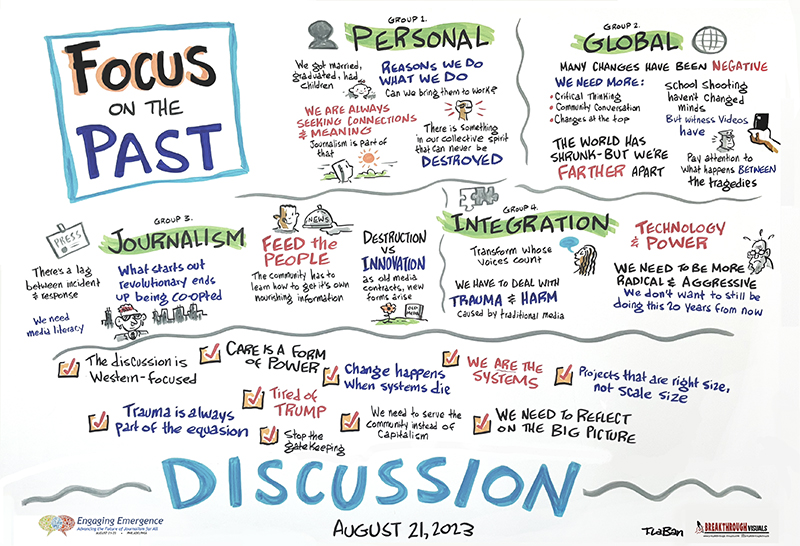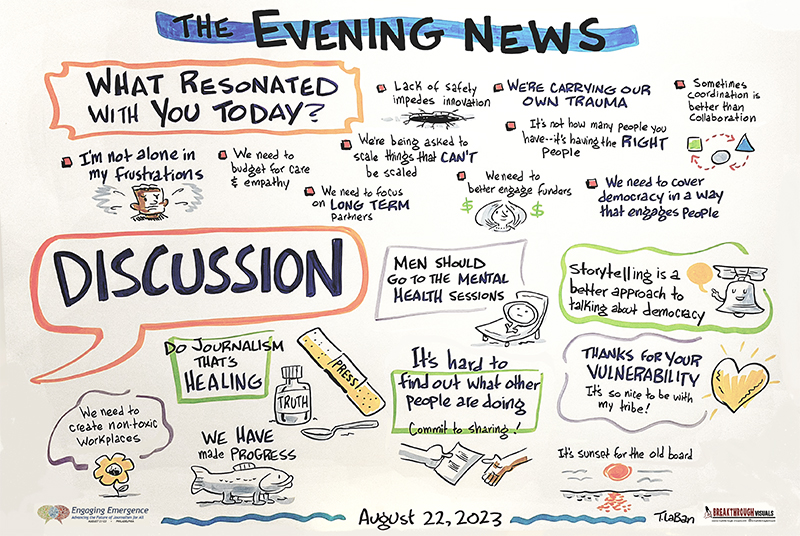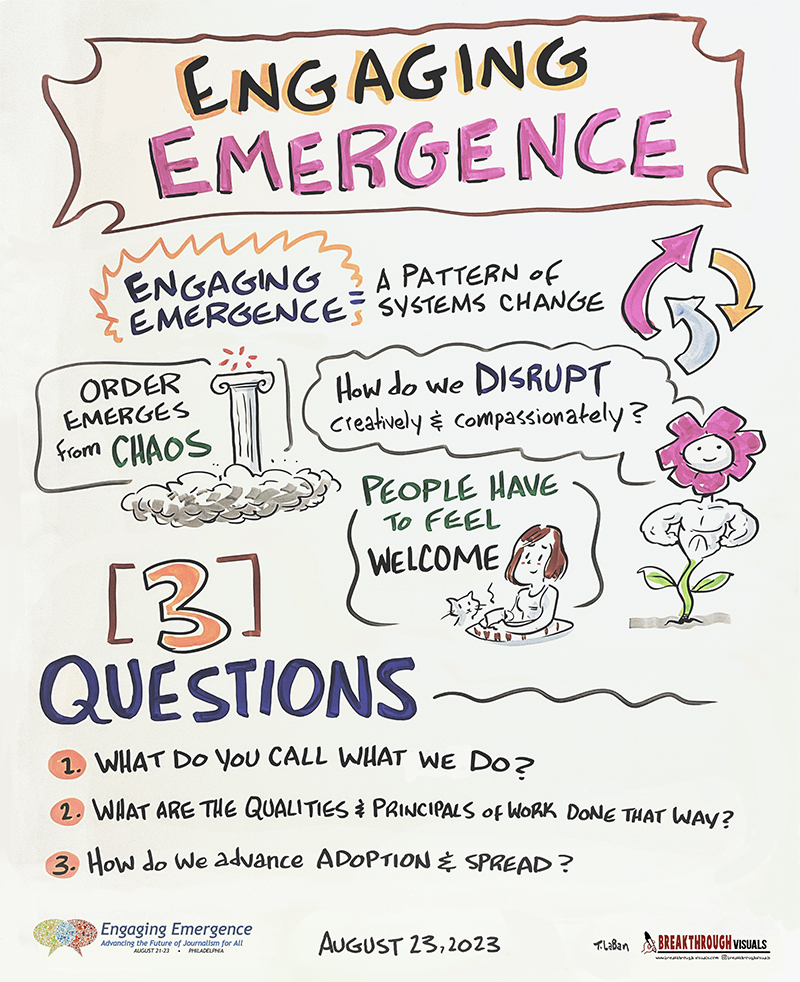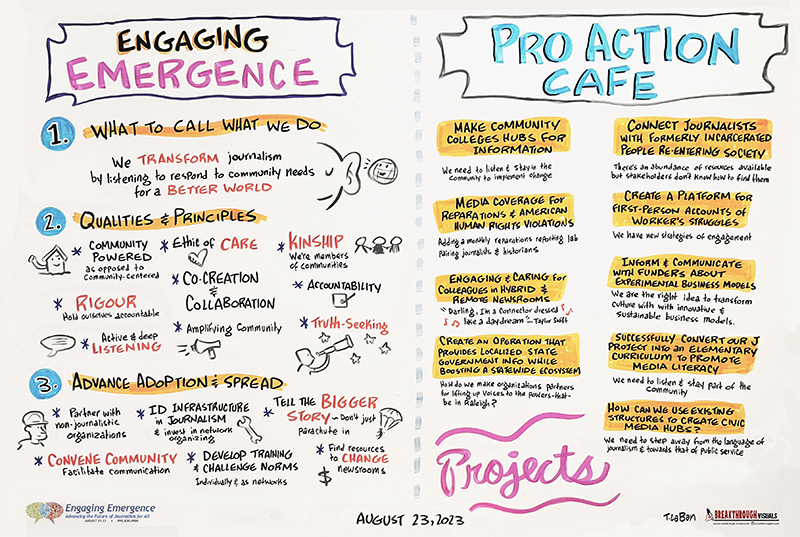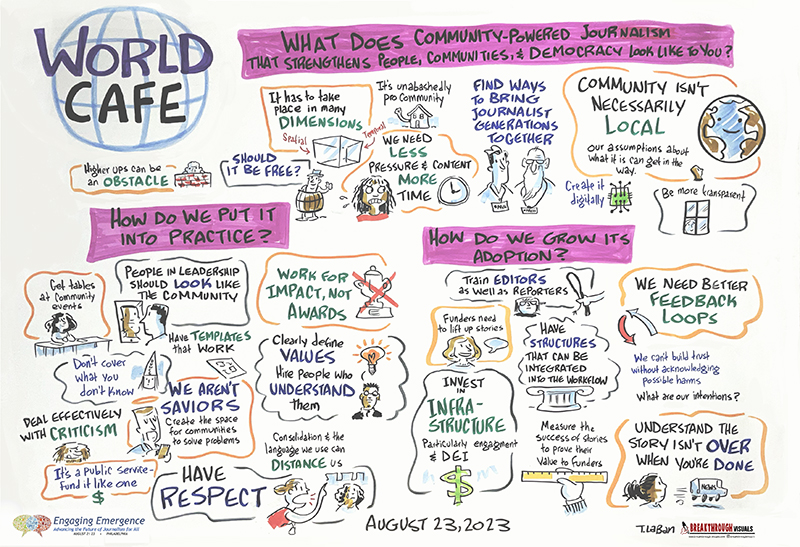Session Proposer/Leader
Heather Blakeslee, Publisher and Editor-in-Chief, Root Quarterly: Art and Ideas from Philadelphia (heather@redpenarts.com)
Session Recorders
Heather Blakeslee // Emily Bargo
Participant List
Alex Keepe, WBEZ
Emily Bargo, Internews
Dylan Smith, Tucson Sentinal
Trip Jennings, New Mexico In Depth
Akshara Vivekananthan, Healthspan Foundation
Amir Richardson, WHYY
Dan Frumkin, Listening to America
Irene McKisson
Scott Blanchard WIFT
Megan Lucen, J+D People’s Newsroom
Issue
Media organizations, whether they be regionally-rooted print media, surgical interventions for certain communities, or larger projects are often asked by funders and supporters how they will “scale.” However, when solutions journalism and community-based media is committed to a place and a people, relationships and trust are paramount, as is not imposing the journalist’s or outlet’s views on the community they are covering—ideally they are part of that community, but that’s simply not possible much of the time. Additionally, there is viewpoint diversity within these communities and identity groups. It should go without saying that not all women, not black people, not all residents of South Philadelphia—pick your identity group—experience the world or think the same. And so how do we consider these two conflicting concepts—one that prioritizes growth and operating “at scale”—a concept that often isn’t clearly defined and whose outcomes are not always good—with the retail, person-to-person relationships and community building required of media organizations that are part of a healthy ecosystem.
CONVERSATION TALKING POINTS
Metrics and scale—are we asking the wrong questions?
Monitoring and evaluation from foundations and supporters require some milestones and metrics, but they sometimes use the language and methods of business or venture capital—Scale! Scale! Scale! As quickly as you can!—rather than looking to long-term and sustainable growth that requires multiple year grants—sometimes over a decade or more to really make a difference.
There are also a lot of things about “scale” that are truly awful: consider factory farming, or the exploitation of workers in factories whose companies have achieved scale. The idea of scaling something that is actually good for society may sometimes be a non-starter unless we look at the externalities. So what size is the right size for a project? Must we make a mouse into an elephant? What is in the DNA of a project?
One suggestion would be to put retail-level person-to-person interviews in a database to be able for other journalists to access. But can we trust our fellow interviewers? What is the context? The devil may be in the details here. 80% of human communication is non-verbal, and so how would words in a database really help us?
But just the process of talking with people is part of the product here. The act of questioning, searching, itself changes community dynamics and could build trust.
At WHYY, they strive to keep conversation intimate—they aren’t town halls. In their conversations across difference series, we wondered whether there was follow-up. Did the participants become more open-minded? More willing to come to conversations in a good-faith way, where they ask clarifying questions to understand rather than to convince, as Braver Angels uses in its methodology?
In a Braver Angels “red/blue” workshop in PA in 2020, both sides agreed that our politicians don’t represent us, that we are worried about big media and big tech consolidating power, and that we need to reclaim our communities from polarized discourse. We actually do have common ground.
There has been a massive shift against civil dialogue (which doesn’t always mean “polite” or “tone policing”—see Alexandra Hudson’s new book “The Soul of Civility”)
How do we invest in the people who are modeling behavior that results in good outcomes?
The other replication crisis
Sometimes, when foundations say scale, they mean replicate—how can I do this project/program in another locale? This is similarly unhelpful. How many times do we have to see that local and regional programs are just that: local and regional. They rely on geography, local leaders, local cultures and norms, history, and many other factors that are simply not analogous to other places. That is not to say that you can’t take some of the bones of an idea and take it someplace else, but as Seth Kaplan writes in his forthcoming book “Fragile Neighborhoods,” the neighborhood is the single most important unit in social cohesion. Shouldn’t our media business models take that into account? And shouldn’t foundations and other investors?
What is our value? Impact?
We need to be seen by more people as more valuable—as relevant—to their lives. So it makes a difference what language we use. Journalism is an act of collective sensemaking. We’ve lost that art. How can we map and understand our own influence? And then how can we make the case for funding that impact?
We need to set the expectations from the beginning, especially when working at the community level: this is what you can get from us and this is what you can’t get from us because it’s not possible. We need to engage in participatory budgeting in that regard, engaging who we hope to serve in deciding what we put our resources into.
Trust
Trust is missing when it comes to the media, and it can only be built over time with consistent relationships. And maybe we can’t get content out of those relationships that require trust. And you can’t replace trust. Change moves at the speed of trust. How do we solve this?
Viewpoint Diversity
- We’re working in a context of organized opposition to talking with one another. Politics has taken over absolutely everything.
- We need to change our collective stance from one of convincing to understanding. If we’re trying to convince, we’ve already lost.
- Media business models are incentivizing the wrong behavior and we have to reverse that, which requires foundations and others to help at the ground level with new kinds of business models that can become sustainable over time—which again speaks to the need for long-term relationships with funders and supporters who understand that even a three-year timeline is likely not enough.
- How do we organize and illuminate the “exhausted majority” of the country, as outlined in the More In Common “Hidden Tribes” report? Why do we continue to cater to the extremes? Local news went away and so there is no one to represent the vast majority of the country. Are there any media funders out there who care about this? Most of them are attached to extreme progressive ideology (including places such as the Independence Public Media Foundation in Philadelphia, whose funding guidelines may not even be legal as they potentially violate the Civil Rights Act) and that’s just not who most Americans are.
- We currently have a high threshold for outrage, which is one of the “high value” emotions that our media models are often based on. Others include rage, fear, and disgust. How do we switch those to positive high value emotions such as awe, wonder, and joy to get away from the “if it bleeds it ledes” mentality? Solutions-based journalism should consider the latter emotions as a framework. We want a better society. We can’t build it on fear and outrage.
- Local and regional news is less polarized and therefore more trusted, and given that it’s our personality as journalists and editors to question authority, norms, and to be naturally curious, we’re actually well-positioned to help reverse the polarization if we approach our communities and communications in a way the privileges better outcomes.
- How do we get more people to be part of the social fabric generally by being part of local government, civic, religious, and other community-based institutions?
ON CONSERVATIVES—Who, what, where?
Ironically, in asking first who are the conservatives, one participant characterized them as people who want to “other” other people and to “control” them. This cartoonish “othering” is exactly why people don’t trust what they perceive as the “liberal” media. We’re engaging in the exact behavior we’re criticizing. We’re all complex, and reducing people to caricatures isn’t helpful.
We asked where the conservatives were at this conference. If they were here, would someone be speaking about them in this way?
What do we even mean when we say conservative?
Is legacy media itself conservative? Are we talking about political conservatism? Are we talking about cultural conservatism of the kind that Yoram Hazony writes about in his book “Reclaiming Conservatism”? How do we address the fact that Latino, black, and Asian communities are more conservative culturally than their white progressive counterparts, and yet are consistently coded as progressive or assumed to be progressive because they are “people of color?”
Should we be using all these labels on people anyway, or just treating them as individuals?
We all define what might constitute liberal and conservative based on our context and surroundings. What’s conservative in the East Village is not what’s conservative in Omaha.
Furthermore, what is our larger context? Why are we not considering how much our biology and psychology influence our experience?
We all believe we should be more curious—but also know the phrase “curiosity killed the cat.” Is this idiom more entrenched in our culture than we think, and does it discourage us from knowing one another better?
It’s possible for local and regional news media to decrease polarization by staying away from labels, assumptions, and just going into communities and talking to people as individuals, without a preconceived narrative. A healthy news ecosystem has to work for that particular locale—which may be a niche, not a vast landscape.
RESOURCES
Hidden Tribes and the Exhausted Majority
A report by More In Common https://hiddentribes.us/
“Fragile Neighborhoods”
By Seth Kaplan
Braver Angels
Political Depolarization Organization
“The Soul of Civility”
By Alexandra Hudson
Blueprint: On the Evolutionary Origins of a Good Society
By Nicholas Christakis
“The Righteous Mind: Why Good People are Divided by Politics and Religion”
By Jonathan Haidt
On “High Value” Emotions and how they’re embedded in current media models
See research by Molly Crocket at the Yale Human Nature Lab
“Reclaiming Conservatism”
By Yoram Hazony




